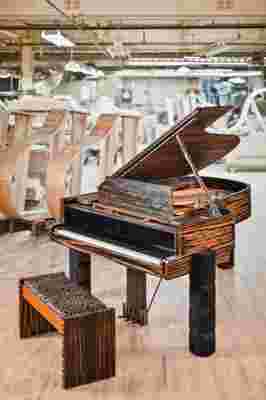Lenny Kravitz Designs a Showstopping Piano for Steinway & Sons
Lenny Kravitz is often thought of as the ultimate guitar guy. From the bombastic riffs of “Are You Gonna Go My Way” to the opening of “American Woman,” guitar arrangements have always anchored Kravitz hits. “But the piano was actually the first instrument I ever played,” he notes, reflecting on his long-standing love of the instrument. Some five decades, 11 studio albums, and four Grammys later, Kravitz still has his childhood piano. Now he has parlayed that passion—along with his experience designing both furniture and interiors —into a limited-edition version all his own, collaborating with the venerable piano manufacturer Steinway & Sons .
A visual tour de force, his concept marries elements of the Art Deco and Art Moderne styles with nods to African art, mixing rich woods and metals. Hand-painted geometric carvings run across the piano’s lid and sides, referencing traditional tribal motifs, while cheetah-print upholstery tops the bench. But the most showstopping feature may be the poplar legs, whose blocky heft and distinctive notchings were inspired by the West African sculptures that Kravitz has long collected. Resembling charred timber, these structural supports mark a surprising departure for Steinway—which has been creating instruments for the world’s leading musicians since 1853. “When I first presented my sketches, they definitely were not entirely sure how the legs were gonna turn out,” Kravitz recalls. “But the more time they spent on them, the more excited they would become.”

The completed instrument, one of 10 limited-edition pieces designed by Kravitz for Steinway .
Kravitz comes to Steinway as the latest creative partner tasked with conceiving a limited-edition piano—following in the footsteps of such visionaries as fashion designer Karl Lagerfeld and sculptor Dale Chihuly. “He’s a true Renaissance man,” says Steinway president and CEO Ron Losby, explaining why Kravitz’s vast range of talents made him an obvious choice. “He’s a musician, a photographer, a designer—with a fantastic sense of style in everything he does.”
Altogether, the expert artisans at Steinway’s vast Queens facility will spend some 200 hours hand-carving each instrument, the rim of which is crafted from 15 layers of rock maple, then accented with two layers of Macassar ebony veneer. The team also worked with other members of the Queens creative community: The lyre that supports the piano’s pedals is cast in solid bronze at the nearby Modern Art Foundry, coincidentally located in the Steinway family’s historic former mansion. Although Kravitz’s scheme was ambitious, it never strayed beyond Steinway’s repertoire of possibilities. “He pretty much had carte blanche,” Losby says. “But because he is a real musician, he was extremely sensitive to what was practical.”
Steinway will produce a mere 10 pianos, each priced at $500,000—with a portion of the proceeds benefiting the Harlem School for the Arts. “I studied there when I was a kid,” Kravitz notes of the organization, an official Steinway partner for nearly a decade. “It was really a wonderful fit.” As for an ideal fit for his pianos, he can imagine one displayed in the home of collectors at the level of Yves Saint Laurent. “He had such an eclectic aesthetic and strong appreciation for African sculpture and art. And this piano is really as much an instrument as a piece of art.”